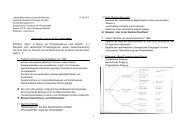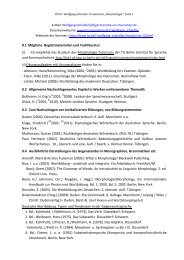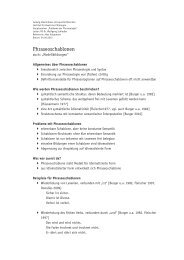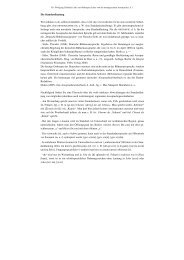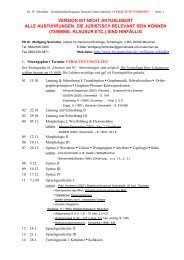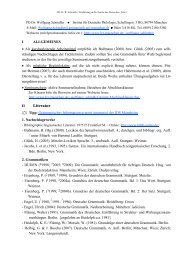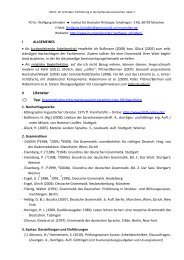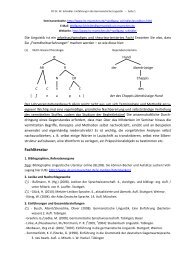Chapter 18 Lexical Functions: Description of Lexical Relations in a ...
Chapter 18 Lexical Functions: Description of Lexical Relations in a ...
Chapter 18 Lexical Functions: Description of Lexical Relations in a ...
You also want an ePaper? Increase the reach of your titles
YUMPU automatically turns print PDFs into web optimized ePapers that Google loves.
—<strong>Chapter</strong> <strong>18</strong>. <strong>Lexical</strong> <strong>Functions</strong>— 97<br />
English DSynt-tree (20)´, which is ensured by a relatively simple and straight-for-ward bil<strong>in</strong>gual<br />
<strong>in</strong>dex:<br />
(20) LiquOper 1<br />
I II III<br />
JEAN MOI HABITUDE<br />
(20)´ LiquOper 1<br />
I II III<br />
JOHN I HABIT<br />
In the process <strong>of</strong> synthesis, (20)´ will be realized as John broke me <strong>of</strong> this habit, this time us<strong>in</strong>g<br />
an English monolongual dictionary where the values <strong>of</strong> LFs are specified.<br />
In phrases <strong>of</strong> this type only the noun requires actual transfer, i.e., look<strong>in</strong>g up <strong>of</strong> its English<br />
equivalent(s). The search for the ‘bizarre’ correspondence DÉTOURNER = BREAK <strong>in</strong> the context <strong>of</strong><br />
HABIT is avoided altogether: BREAK will be computed as an element <strong>of</strong> the value <strong>of</strong> the LF<br />
LiquOper 1 (HABIT) <strong>in</strong> a monol<strong>in</strong>gual English dictionary. Normally, multil<strong>in</strong>gual translation <strong>in</strong> all<br />
possible directions between n languages requires 2n! dictionaries (n! is the number <strong>of</strong> language<br />
pairs, and there are two directions; for five languages, 2 × (5 × 4× 3 × 2 × 1) = 240 transfer<br />
dictionairies are needed. However, if we are us<strong>in</strong>g LFs, for the transfer <strong>of</strong> collocations it is<br />
enough to have detailed and accurate MONOLINGUAL dictionaries with LFs; LFs appear then as a<br />
convenient transfer <strong>in</strong>terl<strong>in</strong>gua.<br />
To make this procedure clearer, let me cite a series <strong>of</strong> correspondences that can be easily<br />
expressed <strong>in</strong> terms <strong>of</strong> LFs (the example is adapted from Fontenelle 1993):<br />
Eng. HABIT ⇔ Fr. HABITUDE<br />
IncepOper 1 acquire, develop, form [ART ~], contracter, prendre [ART ~]<br />
get [<strong>in</strong>to ART ~], take [to ART ~]<br />
F<strong>in</strong>Oper 1 drop [ART ~], get out, get rid abandonner, perdre [ART ~]<br />
[<strong>of</strong> ART ~], ...<br />
LiquOper 1 break [NX <strong>of</strong> ART ~], wean [NX from détacher, détourner [NX de ART ~]<br />
ART ~]<br />
Liqu 1Oper 1 break (<strong>of</strong>f), kick, shake (<strong>of</strong>f), throw se débarrasser, se défaire [de ART ~],<br />
<strong>of</strong>f [ART ~] renoncer [à ART ~], rompre [avec ART ~]<br />
CausFunc 1 <strong>in</strong>still [ART ~ <strong>in</strong>(to) NX] <strong>in</strong>culquer [ART ~ à NX]<br />
Figure 20.4: <strong>Lexical</strong> Correspondences Expressed <strong>in</strong> Terms <strong>of</strong> LFs


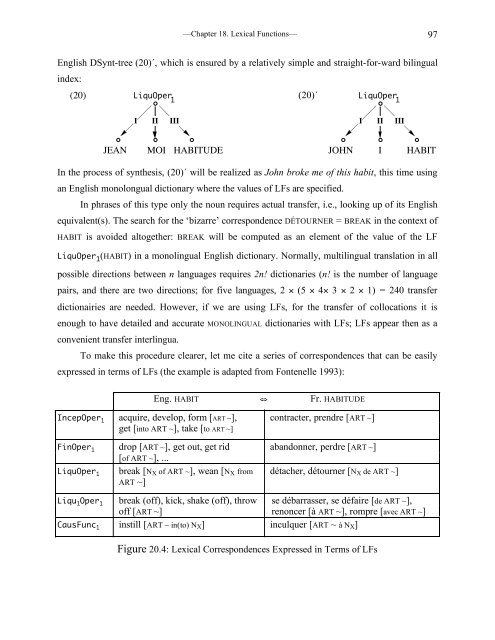
![E-Mail: Wolfgang.Schindler[ätt]germanistik.uni-muenchen.de Web ...](https://img.yumpu.com/51590147/1/184x260/e-mail-wolfgangschindlerattgermanistikuni-muenchende-web-.jpg?quality=85)
